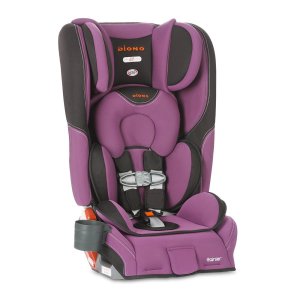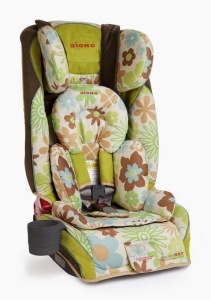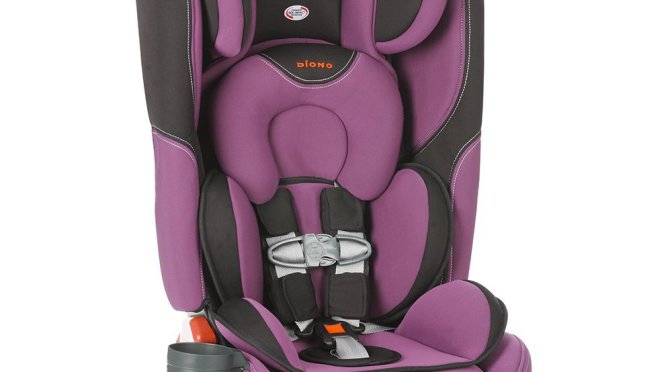 The Diono Rainier is one of the four seats with the highest rear-facing limits currently available in the United States. The other three are the Diono Pacifica, the Clek Foonf, and my personal favorite convertible car seat, the Clek Fllo.
The Diono Rainier is one of the four seats with the highest rear-facing limits currently available in the United States. The other three are the Diono Pacifica, the Clek Foonf, and my personal favorite convertible car seat, the Clek Fllo.
The Rainier is essentially the direct descendant of and update to the Diono Radian RXT. On the outside, both seats look almost identical, with the exception of the flaring sides present on the Rainier.
Both seats are great, as I’ve discussed in my reviews of the RXT and the Rainier here, but if you’re a new parent, or a parent newly introduced to the wonderful idea of Extended Rear-Facing, you might have a hard time telling the difference between the two seats, and why the Rainier is worth around $100 more than the RXT, depending on which color you’re looking at. Here are my thoughts on the matter, based on my knowledge of both seats and experience with extended rear-facing.
Is the Rainier Worth It Over the RXT?
 In short, I do think the extra for the Rainier is worth the difference under certain conditions, but not all. Looking at the seats on paper, you can RF to 50 pounds in the Rainier while to 45 pounds in the RXT. You can FF to 90 pounds in the Rainier and to 80 pounds in the RXT. The height limits are the same on both seats throughout the RF, FF, and booster ranges. The Rainier offers 2 more years of product life as a booster than the RXT at 12 vs. 10 years, but the harnessed lives remain the same. The Rainier is significantly wider to add to side impact protection. Those are the main differences.
In short, I do think the extra for the Rainier is worth the difference under certain conditions, but not all. Looking at the seats on paper, you can RF to 50 pounds in the Rainier while to 45 pounds in the RXT. You can FF to 90 pounds in the Rainier and to 80 pounds in the RXT. The height limits are the same on both seats throughout the RF, FF, and booster ranges. The Rainier offers 2 more years of product life as a booster than the RXT at 12 vs. 10 years, but the harnessed lives remain the same. The Rainier is significantly wider to add to side impact protection. Those are the main differences.
With that said, I honestly think the RXT is as good as or perhaps a better value than the Rainier right now, given the price differential between the two seats. The 5 pound RF advantage of the Rainier is most relevant if you’ve got a heavier child; ditto with the 10 pound FF advantage. Since the top heights of both seats are the same, a child who would outgrow the RXT by height by 45 pounds wouldn’t get any more time RF in the Rainier. On the other hand, a heavier child could benefit from the increased weight limits, as the weight of a child doesn’t impact his or her safety when it comes to RF vs. FF; the position of the seat and the age of the child make far more of a difference. As noted here, the benefits of RF are visible in differential death rates for children at least up to 4 years of age, regardless of what the children weigh.
So should I buy the Rainier or the RXT?
I would recommend the Rainier over the RXT under the following conditions. Note that most of these points also apply to the Pacifica, which is essentially the same seat as the Rainier without the head wings.
1.) You want the best protection money can buy in a car seat for your children. There is no seat currently available in the US that offers a greater span of protection than the Diono Rainier, with its 50 lb rear-facing, 90 lb front-facing, and 120 lb booster range. Of course, the booster range isn’t going to be very useful for most children once they outgrow the FF range, due to the identical top harness height for the FF and booster modes, but that’s an issue common to all Diono seats, so I’m not going to hold that against the Rainier in particular.
2.) You’ve got a child who’s high in both weight percentiles and likely to surpass 45 pounds before turning 4 or 5, which is when I’d suggest forward-facing. Similarly, you’ve got a child who is not likely to outgrow the height limits of the Rainier before reaching 45 pounds; this means the child would be able to rear-face for longer in the Rainier due to the extra 5 pound window.
3.) You don’t need 3 across, or you have a large car, minivan, or SUV to do it in. By large, I mean a wide vehicle (ideally at least 75 inches wide). This is due to the sides of the Rainier; the bases of the seats are the same width, but the Rainier flares out significantly while the RXT does not. The width point is particularly important to consider, as that’s an area where the RXT is clearly superior to the newer Dionos.
I’ve compared both during installations, and there’s no question that the flaring out design of the sides of the newer Dionos makes them more difficult to puzzle with other car seats when trying to set up 3 across installations. It’s still possible to do 3 across with a new Diono, but not to the degree that it is with an older one like an RXT or a Radian. Keep this in mind if you’re driving a small class vehicle like a Prius, Civic, Corollla, or Insight. You might want to see what kinds of 3 across combinations are commonly used in your vehicle here.
4.) You want the extra side impact protection of the larger flared sidewalls of the Rainier. Diono claims they offer enhanced side protection compared to previous Diono seats and are packed with EPS foam. Given the speed with which side impacts can become severe, anything that can add an extra layer of safety and protection is certainly worth considering. Of course, keeping your child RF longer in an RXT will provide more side impact protection than FF in a Rainier, so keep the big picture in mind as well.
5.) You have a shorter child and want the assurance that s/he will be be able to make it from infancy through a boostering age. Because the Rainier offers 2 extra years of product life when used as a booster compared to the RXT, you’d have a better chance of the Rainier being the first, last, and only car seat you ever need. Of course, this will also depend on how your child grows, and keep in mind that most children aren’t ready for full seat belt use until they are between 10 and 12 years old.
6.) You have the extra $100. I generally don’t feel money should be a deciding factor when looking at ways to keep children from dying in motor vehicle collisions, but everyone’s got a budget, and this is going to be what makes the difference for some folks, and that’s okay.
If you can satisfy at least some of those conditions, then the Rainier is for you. If not, the RXT will also keep your child safe. The newer Diono seats are definitely flashier, come with longer product lives, and in the case of the Rainier and Pacifica, higher RF limits. However, none of this changes the effectiveness of the Radian RXT. If you don’t need the newer belts and whistles or are looking to save a bit of money, I’d suggest looking seriously at the RXT alongside the newer Dionos. At this level, your driving abilities will make much more of a difference than the seat. Drive the speed limit and rear-face to the limit in either seat.
You can buy the RXT here and the Rainier here. Canadians can buy the RXT here and the Rainier here.
—
If you find the information on car safety, recommended car seats, and car seat reviews on this car seat blog helpful, you can shop through this Amazon link for any purchases, car seat-related or not. Canadians can shop through this link for Canadian purchases.


